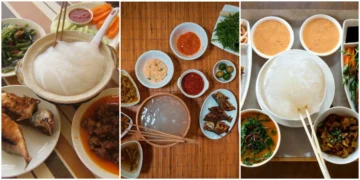In the heart of Central Africa, the Democratic Republic of the Congo (DRC) is a land of vast rainforests, winding rivers, and a tapestry of ethnic traditions that have endured through centuries of change. Among the nation’s many culinary treasures, Poulet à la Moambé stands out as the best food of Democratic Republic of Congo—a dish that transforms humble ingredients into a comforting, deeply flavorful stew. Often referred to as “chicken in palm nut sauce,” Poulet à la Moambé embodies the rich natural bounty of the region, the resourcefulness of its people, and the art of slow cooking that has been perfected over generations.
Why Poulet à la Moambé Is the Best Food of Democratic Republic of Congo?

Poulet à la Moambé has long been celebrated in the DRC for its ability to bring together an array of flavors that resonate with both tradition and modern taste. Its magic lies in the marriage of tender, slow-cooked chicken with a luxuriously creamy sauce made from palm nut paste—a staple ingredient in Congolese cooking. The dish strikes an exquisite balance between the natural sweetness of the palm nut and the savory, earthy notes contributed by aromatics and spices. More than just a meal, Poulet à la Moambé is a culinary ritual that symbolizes communal sharing and resilience. It is enjoyed at family gatherings, community celebrations, and even in urban restaurants, reflecting a deep cultural pride and the enduring spirit of the Congolese people.
Key Ingredients of Poulet a la Moambe
The distinctive character of Poulet à la Moambé is born from a carefully selected combination of local ingredients:
- Chicken: High-quality, locally sourced chicken (preferably free-range) forms the protein base. The meat is often cut into pieces that, when slow-cooked, imbued with the rich flavors of the sauce.
- Palm Nut Paste (Moambé): Central to the dish is the palm nut paste, made by boiling and mashing the flesh of palm fruits. This paste provides a naturally sweet and nutty flavor that defines the sauce.
- Aromatics: Onions, garlic, and sometimes ginger are sautéed to form a fragrant foundation. These ingredients contribute depth and a subtle sweetness that complements the richness of the palm nut.
- Tomatoes: Fresh or lightly stewed tomatoes are added to balance the earthy flavors with a hint of acidity and natural sweetness.
- Spices: A traditional blend of salt, black pepper, and sometimes chili or paprika is used to introduce warmth and a mild kick, enhancing the overall complexity.
- Oil: Vegetable oil or a bit of palm oil is used for sautéing, ensuring the aromatics release their flavors fully while adding to the sauce’s overall texture.
- Optional Enhancers: Some family recipes may incorporate a touch of peanut butter or beef broth to further enrich the sauce, reflecting regional variations within the DRC.
Prepare Poulet a la Moambe (Best Food of Democratic Republic of Congo)

-
Preparing the Chicken: The process begins with cleaning and cutting the chicken into uniform pieces. The meat is lightly seasoned with salt and pepper, and in some recipes, a brief marination with garlic and ginger is allowed to enhance flavor penetration.
-
Sautéing Aromatics: In a large, heavy-bottomed pot, oil is heated over medium heat. Finely chopped onions, garlic, and ginger are sautéed until soft and fragrant, creating a robust flavor base. This step is essential, as the caramelized aromatics contribute significantly to the sauce’s depth.
-
Building the Sauce: Chopped tomatoes are then added to the pot, allowing them to simmer and break down into a cohesive mixture. Once the tomato base has thickened slightly, the palm nut paste is stirred in. At this point, one can add traditional spices—such as bay leaves, black pepper, and a hint of chili. Some cooks choose to deglaze the pot with a splash of water or broth.
-
Braising the Chicken: The seasoned chicken pieces are returned to the pot, where they are gently simmered in the developing sauce. The slow cooking process, which can last between 1 to 2 hours, is crucial. It allows the chicken to become tender while absorbing the complex flavors of the palm nut-based sauce. The sauce thickens gradually then creating a luxurious consistency that coats each piece of chicken perfectly.
-
Final Adjustments: As the dish nears completion, the sauce is tasted and adjusted for salt and acidity. A squeeze of fresh lime or a dash of additional seasoning may be added to brighten the overall flavor. The result is a deeply aromatic, richly textured stew that embodies both the simplicity and complexity of Congolese cuisine.
What Makes Poulet à la Moambé Unique?
Poulet à la Moambé is unique in its ability to transform everyday ingredients into a luxurious dish. The distinctive use of palm nut paste sets it apart from other stews, infusing the dish with a natural sweetness and nutty flavor that is unmistakably Congolese. Then the slow braising technique ensures that the chicken becomes melt-in-your-mouth tender. While, the harmonious blend of tomatoes, aromatics, and spices creates a sauce that is rich and satisfying.
Furthermore, the dish reflects the cultural diversity of the Democratic Republic of the Congo. It has evolved over centuries through a melding of indigenous culinary practices. It has influences by European colonizers and neighboring African cuisines. This fusion of traditions is what makes Poulet à la Moambé a beloved dish. It serves as a culinary ambassador that conveys the resilience, creativity, and warmth of the Congolese people.
History of Poulet a la Moambe

The history of Poulet à la Moambé is interwoven with the agricultural and cultural narratives of the DRC. Palm trees have long been a vital resource in the region. It provides not only sustenance through its fruit but also materials for building and traditional crafts. It is within this context that the technique of creating palm nut paste was refined.
Historically, this dish was prepared as a communal meal, with families and village communities gathering around large pots. Its evolution from a humble peasant dish to a celebrated national specialty reflects the ingenuity of the Congolese people. Today, Poulet à la Moambé continues to be a symbol of national pride and culinary excellence in the DRC.
Other Authentic Delicacies
- Moambe Fish: Similar to its chicken counterpart, this dish features locally caught fish simmered in a palm nut sauce.
- Fufu: A starchy side dish made from cassava, plantains, or yams, fufu serves as the perfect accompaniment.
- Saka-Saka: A dish made from cassava leaves cooked with peanuts and spices
- Grilled Goat: A popular dish at social gatherings, grilled goat is seasoned with indigenous spices.










Discussion about this post